A canal shows the creativity of Jiangsu’s humanistic beauty.
Millennium Canal, rushing endlessly.
In June 2017, the General Secretary of the Supreme Leader made an important instruction that "the Grand Canal is a precious legacy left by our ancestors and a mobile culture, which should be well protected, inherited and utilized". This has pointed out the direction and provided guidance for promoting the construction of the Grand Canal Cultural Belt.
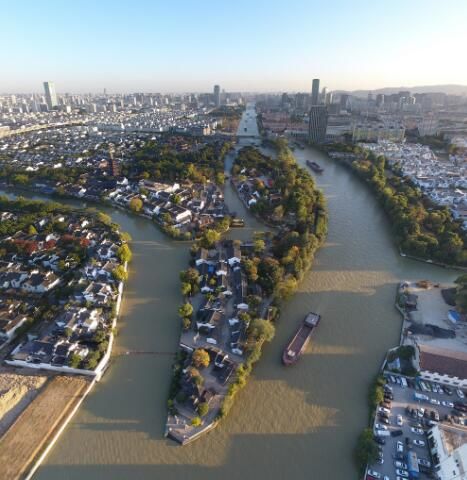
Beijing-Hangzhou Grand Canal Suzhou Hanshan Temple Section
Jiangsu is the province with the longest river along the Grand Canal, the largest number of cities flowing through it, the richest canal heritage and the largest number of sites listed in the World Cultural Heritage. The Grand Canal in China is about 3,200 kilometers long and the Jiangsu section is 790 kilometers long. It can be said that the Grand Canal is a living exhibition hall of Jiangsu culture, a bright pearl of world heritage and a beautiful green corridor.
Over the past three years, Jiangsu has kept in mind the entrustment of the General Secretary, made every effort to promote the construction of the Grand Canal Cultural Belt, and made three major articles: careful protection, effective inheritance and rational utilization. On the basis of protection, efforts will be made to promote the innovative inheritance and creative transformation of the Grand Canal culture, endow the Grand Canal with new characteristics of the times and cultural values, and make a river show the beauty of culture, ecology, construction and people’s life, thus writing a contemporary chapter for the Millennium Grand Canal.
Let’s take a look at the wonderful cases in 11 cities along the Jiangsu section of the Grand Canal — —
Xuzhou: Huaihai Campaign Martyrs Memorial Tower (Pavilion)
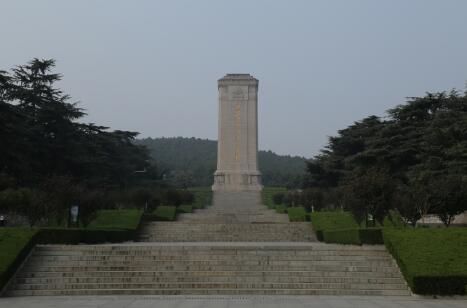
Huaihai Campaign Martyrs Memorial Tower (Museum) (Photo courtesy of Propaganda Department of Xuzhou Municipal Committee)
The Xuzhou section of the Grand Canal is 201 kilometers long. Prehistoric civilization, Chu-Han culture, red culture and celebrity culture are listed on both sides of the canal like pearls. During War of Resistance against Japanese Aggression, Xuzhou was an important guerrilla area of the famous anti-Japanese armed canal detachment active on both sides of the canal; On January 10, 1949, the 65-day Huaihai Campaign ended successfully in Xuzhou, killing more than 555,000 people. Today’s Huaihai Campaign Memorial Hall is a famous patriotic education base and a red tourist attraction in China, and it has been selected as one of the 100 "classic red tourist attractions" in China. The names of 28,396 martyrs are engraved in the stele gallery of the Martyrs Memorial Tower in the museum. Since 2014, the Memorial Hall has started the "Rescue Interview Project for the Witnesses of Huaihai Campaign", which lasted for three years, covering 729 witnesses, collecting more than 1,200 pieces of historical cultural relics and sorting out 2 million words of oral materials. The narrator went to colleges and universities to give a lecture on "Red Stories on Campus" and went into primary and secondary schools to tell red stories, with a total of 160,000 students being taught.
Suqian: Longwang Temple Palace
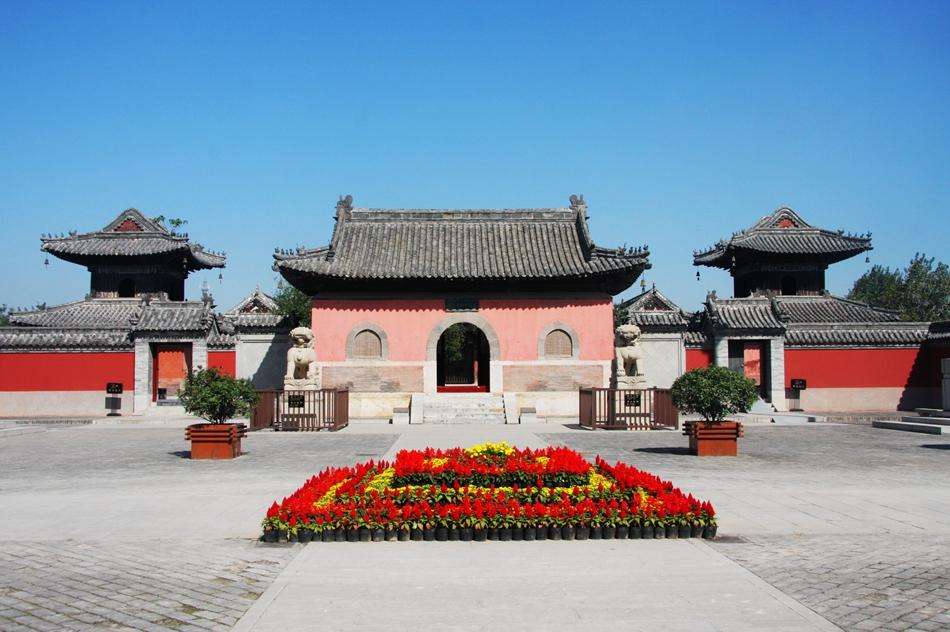
Longwang Temple (Photo courtesy of Propaganda Department of Suqian Municipal Committee)
In the Qing Dynasty, Emperor Qianlong went to the south of the Yangtze River for six times and stayed in Suqian for five times, which gave him the praise of "the benefits of being the first mountain in spring". Today, the Qianlong Palace, where Qianlong stayed at that time, originally named "Building Longwang Temple in An Lan", is still well preserved. It is the most precious architectural cultural heritage in Suqian and the only world cultural heritage site in Suqian section of the Grand Canal.
Zaohe Ancient Town, where Longwang Temple Palace is located, is an important town in the south wing of the Grand Canal. In recent years, Suqian has invested about 150 million yuan to protect and develop the history and culture of Zaohe Ancient Town as a whole. The Longwang Temple Palace has been protected and repaired in three phases, and the fallen colored paintings have been repaired. In August this year, the construction of "Zaohe Dragon Town" was started. The overall layout of "One Source, Three Veins and Ten Crossing" highlighted the immersion experience, performing road show and cultural exhibition, and recorded and told the long canal story in Suqian. The ancient Longwang Temple Palace glowed with new vitality of the times. Visitors here will fully appreciate the water control culture, shipping culture and royal cruise culture of Suqian section of the Grand Canal.
Huaian: Shuishang Interchange
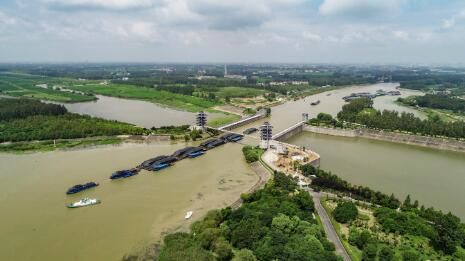
Water Interchange (Photo courtesy of vision china)
In the Ming Dynasty, Pan Jixun, a water conservancy expert, led the construction of dikes on the east bank of Hongze Lake to raise the water level, so as to form a torrent to wash away the sediment deposited in Qingkou of the Yellow River. Over the past 400 years, more than 40 water conservancy projects have been formed here, including dikes, gates, dams, weirs and diversion piers. Nowadays, when people come to the water interchange in the southern suburbs of Huai ‘an, they can see the wonders of the Huaihe River and the Beijing-Hangzhou Grand Canal. The Huaihe River flows to the Yellow Sea from west to east on the riverbed below, hanging 6 meters above it, and ships shuttle on the north-south Beijing-Hangzhou Grand Canal, which is a busy scene. The ancient canal and advanced modern technology meet here, and the wisdom of water control of China people for more than 400 years is presented here.
The Grand Canal has been flowing for thousands of years, forming a golden waterway with flowing gold and silver, and also accumulating historical and cultural relics on both sides of the strait. The annual throughput of Huai ‘an Shiplock is nearly 290 million tons, ranking first in China. Huai ‘an took the lead in opening port container transportation in Subei Canal, with annual throughput accounting for 75% of the province’s inland rivers.
Yangzhou: China Grand Canal Museum
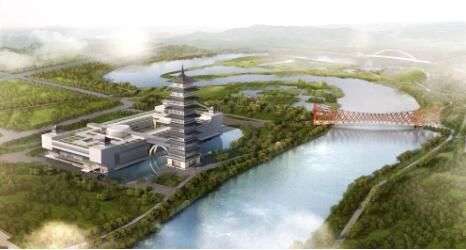
China Grand Canal Museum (Photo courtesy of Yangzhou Sanwan Scenic Area)
As the origin city of the Grand Canal and the leading city for applying for the World Heritage of the Canal, Yangzhou was born and prospered because of the Canal.
In May, 2018, Zhang Jinqiu, academician of China Academy of Engineering and chief architect of China Northwest Architectural Design and Research Institute, led a team to visit Sanwan in Yangzhou, and personally drew the first planning pattern of China Grand Canal Museum. In May 2019, the China Grand Canal Museum started construction in Yangzhou.
The whole design scheme consists of the museum and the main tower. The main tower with four corners (Universiade Tower) is slender and beautiful, and together with the adjacent Wenfeng Tower and Tianzhong Tower, it forms the landscape effect of "three towers reflecting three bays". The boat-shaped museum building incorporates sail elements, and the top floor is connected with the Universiade Tower through a covered bridge with Changhong lying wave image. The whole building has the ancient charm of tang style, suggesting that Yangzhou once had a prosperous scene of "promoting one and benefiting two" in the Tang Dynasty.
At present, the exhibition contents of China Grand Canal Museum are under intense arrangement, which will include the 2,500-year development of Sui and Tang Grand Canal, Beijing-Hangzhou Grand Canal and East Zhejiang Canal, and it is expected to open to the outside world by the end of 2021.
Zhenjiang: Xijindu

Xijindu (Photo courtesy of vision china)
Xijindu has been a battleground for military strategists since the Three Kingdoms, and it is also the first stop for northerners to cross the river south. With the change of time, Guguazhou on the north bank has all collapsed in the river, while sedimentation has begun on the south bank. Xijin Gudu is now more than 300 meters away from the Yangtze River. Although the ancient ferry is no longer there, the "living fossil"-like ancient scenery of Xijindu has been basically preserved.
Today’s Xijindu is both ancient and new: in terms of ancient times, Xijindu historical and cultural block is the most preserved, concentrated and well-preserved area in Zhenjiang, and many buildings are called "orphans" in Jiangsu and even the whole country. Today, cutting-edge artists and young craftsmen creatively integrate the trend culture into the Millennium ancient street. In 2020, Xijindu created an art life festival that lasted for five months. At the same time, Xijindu also implanted new formats such as cultural creativity, water market and interactive experience, and projects and activities such as music, film and television blocks and national wind music festivals, reappearing the bustling scene of "home from the sky, the clouds are sailing".
Changzhou: Qingguo Lane
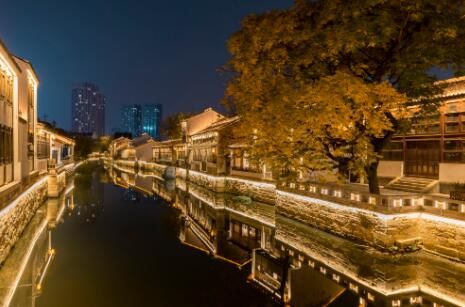
Qingguo Lane (Photo courtesy of vision china)
Qingguo Lane, known as "the first lane of celebrities in the south of the Yangtze River", is one of the most important cultural landmarks in Changzhou section of the Grand Canal. Qingguo Lane is not long, but there are countless outstanding figures between the white walls and the high walls and deep courtyards: in the Ming and Qing Dynasties alone, there were nearly 100 scholars from Qingguo Lane; In modern times, industrialist Sheng Xuanhuai, novelist Li Boyuan, patriotic industrialist Liu Guojun, master of Chinese studies Zhao Yuanren, linguist Zhou Youguang and other famous people all walked out of Qingguo Lane.
Deep curtilage compound is adjacent, flowing water sets each other off, and the depths of the alley are faint. On April 29th last year, the historical block of Qingguoxiang, which carried half of Changzhou’s history, was officially opened. Qingguoxiang Cultural Memory Museum, Zhou Youguang Library (Zhou Youguang’s former residence), Changzhou League History Museum, Tang Jingchuan Memorial Hall and Shi Liang’s former residence were opened one after another. The A side of Qingguo Lane, based on inheritance and taking culture as the soul, has formed the Changzhou Cultural Museum community; The B side of Qingguo Lane, based on the "future", innovates the format and content around the futurity, cosmopolitanism and times of the canal.
Wuxi: Qingming Bridge
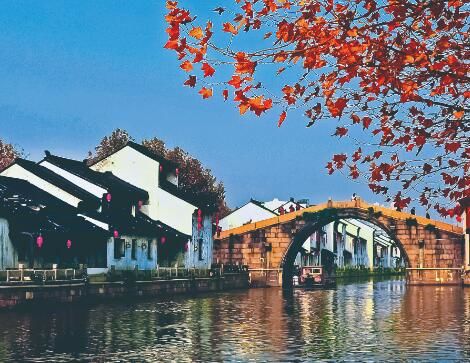
Qingming Bridge (Photo courtesy of the Propaganda Department of Wuxi Municipal Committee)
More than 3,200 years ago, Taibo Benwu settled in Meili, and the oldest canal in the south of the Yangtze River, Bodu Port, was dug in the historical and cultural block of Qingming Bridge, which reached its peak in the Ming Dynasty.
The Qingming Bridge block, where boats and boats come and go constantly, has formed a unique cultural feature of the streets in the south of the Yangtze River, convenient conditions for water transportation, and nurtured the civilization of China’s national industry and commerce.
The rice wharf and cloth wharf, which were developed and prospered by the canal in those years, are now full of creative and intelligent industries, with more than 2,000 Internet of Things enterprises and an output value of more than 200 billion yuan, which has become the highlight moment of Wuxi’s science and technology industry. In recent years, Wuxi has won the brand title of "Jiangnan Water Lane Canal Out of Print" by hosting a number of grand events such as the second Grand Canal Cultural Tourism Expo. Qingming Bridge, Nanchang Street, nanzenji, Xiaolou Lane, Chong’an Temple, Jieguanting Lane, Huangbudun, Beijian Park and other scattered scenic spots are "beaded into a chain and closed into a ring", showing the beautiful scenery of "a thousand-mile canal alone".
Suzhou: Shantang Street
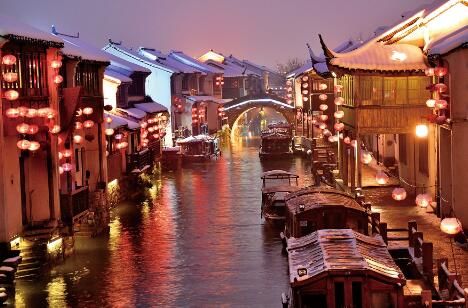
Shantang Street (Photo courtesy of the Propaganda Department of Suzhou Municipal Committee)
A history of canals, a picture of bustling Suzhou. The Suzhou section of the Grand Canal was built in the Spring and Autumn Period, and it was basically finalized in the Sui and Tang Dynasties. In 825 AD, Bai Juyi arrived in Suzhou for secretariat. Seeing that the Huqiu River road was impassable, he dug the Shantang River and built a "water expressway" between the ancient city of Suzhou, Huqiu and the Grand Canal. Emperor Qianlong went to the south of the Yangtze River six times, and every time he went out along the Lishantang to Huqiu. In 2014, the 14.2-square-kilometer Suzhou ancient city was listed as a world cultural heritage.
From Qilishantang to Huqiu, the rich canal resources have made "the first street in Gusu" prosperous for thousands of years. In recent years, Suzhou has built a "Suzhou model" of the Grand Canal cultural belt around protection, inheritance and utilization, and took the lead in setting up the first Grand Canal cultural tourism development fund in the province, establishing a key project library of the Grand Canal cultural belt, inheriting the context in a way of "living protection" and showing the cultural essence of the south of the Yangtze River. Today, Shantang Historic District has become a tourist punch-in resort, and the Kunqu Opera special activities staged in Huqiu Scenic Area have become a new business card for Soviet-style life.
Nanjing: Tiansheng Bridge
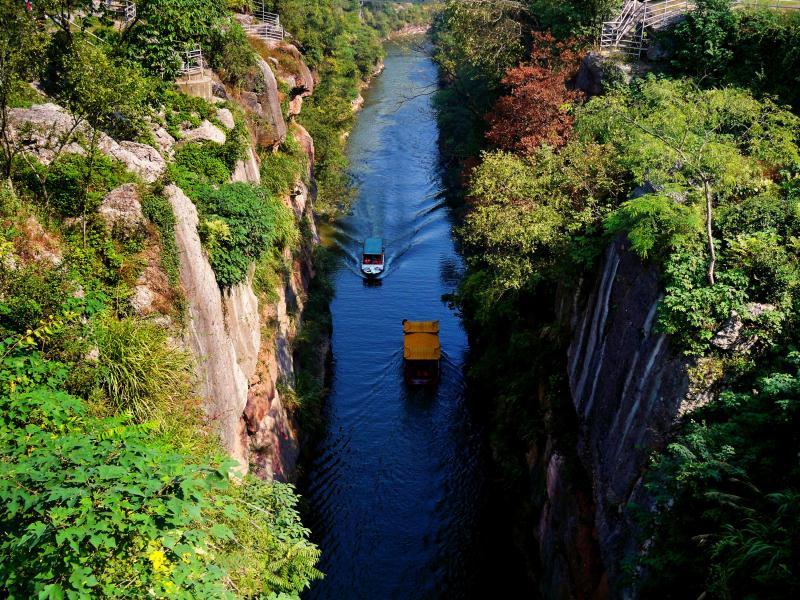
Rouge River (Photo courtesy of vision china)
About 4 kilometers west of Lishui District, Nanjing, Zhu Yuanzhang, the Ming Emperor, dug the Rouge River to communicate the water transportation between Nanjing and Zhejiang. The Rouge River is 7.5 kilometers long, and hundreds of thousands of migrant workers burned stones to dig the river, which took ten years to build. The Rouge River runs through the mountains, leaving a rare spectacle in the world — — Tianshengqiao In 2017, the Canal Culture Exhibition Hall located in the scenic spot — — Tianshengqiao Museum was officially opened to the public. Around the cultural heritage of water transportation and the historical and cultural resources along the canal, the exhibition hall set up a number of interactive exhibition areas, taking cruise ships as the visiting carrier and relying on the 5D interactive experience technology, so that visitors can feel the digging history of Rouge River in an immersive way.
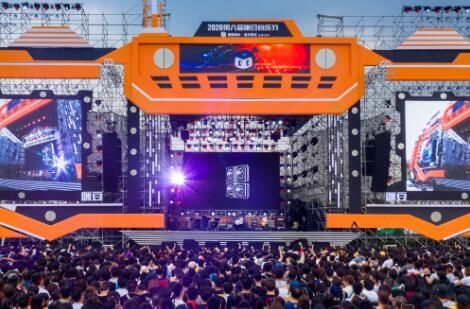
Midou Music Festival (Photo courtesy of the Propaganda Department of Lishui District Committee)
Today, the annual music event "Midou" Music Festival has permanently settled in Tianshengqiao Scenic Area. In October this year, at the 8th Midou Music Festival, more than 100,000 fans enjoyed a hearty audio-visual cultural feast here. Visitors can experience Qinhuai culture, Ming culture and canal culture at the same time in one scene, and enjoy the feast of "tourism+music".
Taizhou: Fengcheng River
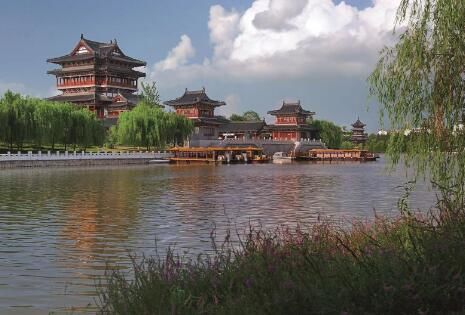
Fengcheng River (Photo courtesy of Propaganda Department of Taizhou Municipal Committee)
In the early years of the Western Han Dynasty, Liu Bi, the king of Wu, dug a salt river from Panxi in Rugao in the east to Zhuyuwan Scenic Spot in Yangzhou in the west. YugutransportThe Fengcheng River, which is connected with the salt river in the same strain, is the moat of Taizhou and the most well-preserved and largest ancient city river in China. As night falls, boating on Fengcheng River is a project that tourists must "punch in" when they come to Taizhou. Boating on the river, Wanghailou, Meiyuan, Liuyuan, Taoyuan, Wenchang Pavilion and Wenfeng Tower … … Multicolored lights outline the pavilions on both sides of the strait, the sound of paddles and the green water. Who can not be drunk?
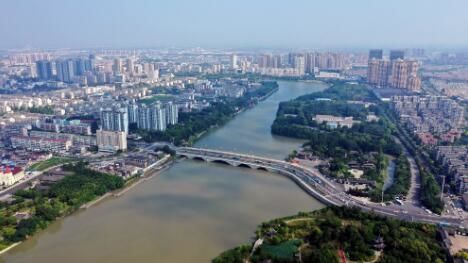
Fengcheng River (Photo courtesy of Propaganda Department of Taizhou Municipal Committee)
The night of Fengcheng River, the more beautiful it is. Taking Wanghailou as the prospect, the 3D water curtain show was staged on the water stage of Sanshuiwan, creating a dazzling fantasy effect on the ancient canal. In Wenlv block of Jing ‘an Road, night tours, night markets, night plays, night shows and night banquets light up the night economy along the canal, where people experience slow life on water, culture and food, and feel the unique charm of this canal water city.
Nantong: 1895 Cultural and Creative Industrial Park
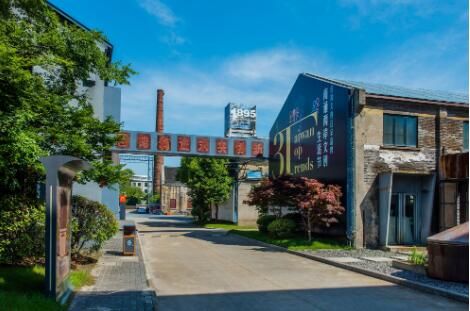
1895 Cultural and Creative Industrial Park (Photo courtesy of the Park)
The canal has given Nantong a long history of cultural spirit and brought it modern civilization. In 1895, Zhang Jian, a patriotic industrialist and educator, took a fancy to the superior geographical position of Tangzha ancient town near the canal and built a large cotton textile enterprise — — Dasheng cotton mill, and set up a series of subsidiary industries with this as the axis.
Today, Tangzha Ancient Town has become the vanguard in the new era to carry forward the spiritual connotation of the canal and highlight the self-confidence of Jianghai culture. The mottled factory turned into a cultural and creative industrial park in 1895, where the oil mill and paper mill attached to Dasheng Cotton Mill were located. The industrial park has attracted more than 40 creative design, digital media, advertising and video production companies to settle in, and has held various literary exhibitions for a long time. In the past few years, countless creative exhibitions have been held here: from root carving to Ming and Qing furniture, from book tickets to ink and oil paints, from home textile products to jade carving pendants, and even a small-scale tasting meeting was held in cross-border cooperation with Sam Supermarket. Thanks to the 1895 Cultural and Creative Industrial Park, the development of Tangzha ancient town is more vigorous and its external attraction is constantly improved.
Link 1:
World Cultural Heritage Site in Jiangsu Section of Grand Canal (28 places)
Reaches: Huai ‘an section of Huaiyang Canal, Yangzhou section of Huaiyang Canal, Changzhou section of Jiangnan Canal, Wuxi section of Jiangnan Canal, Suzhou section of Jiangnan Canal and Suqian section of Zhonghe River.
Historical Remains: Qingkou Hub, Shuangjin Gate, Qingjiang Gate, Hongze Lake Dike, the site of Governor’s Water Transportation Office, Liubao Sluice Reduction Gate, Yucheng Post, Shaobogu Dike, Shao Bo Wharf, Slender West Lake, Tianning Temple Palace, Geyuan, Wanglumen House, Yanzong Temple, Lushaoxu House, Qingming Bridge Historical and Cultural Block, Panmen, baodai bridge, Shantanghe Historical and Cultural Street.
Link 2:
"Six Ones" of Jiangsu Canal
A law
Since January 1st, 2020, the first local regulation "Decision of the Standing Committee of Jiangsu Provincial People’s Congress on Promoting the Construction of the Grand Canal Cultural Belt" has been implemented in China, providing legal protection for cultural heritage protection, adhering to the ecological bottom line and expanding the cultural tourism industry. As the only pilot province of the Grand Canal National Cultural Park in China, Jiangsu has also innovatively compiled the Construction Plan of Jiangsu Section of the Grand Canal National Cultural Park, which promotes the Grand Canal culture to show new charm and glow with new vitality through the organic docking of historical value and practical value.
An exposition
The Grand Canal Cultural Tourism Expo, which has been held twice so far, integrates the cultural tourism resources along the Grand Canal in Jiangsu Province, and strives to build a platform for the integration and development of cultural tourism in cities along the Grand Canal, a platform for the promotion of cultural tourism products and a platform for sharing a better life. The Expo invited thousands of international friends to the cities along the Jiangsu Canal to experience the canal culture and enjoy the beautiful scenery of the canal, to show the rich cultural heritage of the Grand Canal, the beautiful life at present and the creative energy of the integration and development of cultural tourism, and to introduce the cultural tourism products of the Grand Canal to all parts of the world.
A forum
Since 2006, the annual World Canal City Forum has been successfully held for the 14th time in Jiangsu. The forum organized more than 200 participants, including mayors of domestic canal cities, canal managers, researchers and enthusiasts, diplomatic envoys of well-known foreign countries where canals are located, and representatives of international organizations in China. Mayors of foreign canal cities, representatives of well-known canal management institutions and experts and scholars of canal research institutions jointly discussed the paths and countermeasures for the sustainable prosperity and development of the cultural tourism industry in canal cities.
A fund
At the theme forum of "Canal Culture" of the first Yangtze River Delta International Cultural Industry Expo, Jiangsu set up the first Grand Canal Cultural Tourism Development Fund in China with an initial scale of 20 billion yuan. Through the coordinated linkage of mother and child funds, it made overall plans for the protection, inheritance and utilization of the Grand Canal culture, focusing on supporting the construction of the Grand Canal National Cultural Park and the integration of cultural tourism.
A series of books
It took more than 100 experts eight years to compile, and the first China Canal Annals — — China Canal Records was officially published by Jiangsu Phoenix Publishing Media Group. On September 27th last year, this 14-million-word imperial masterpiece was unveiled for the first time at the 2019 World Canal City Forum and World Canal Conference, which is also the largest canal publishing project in China’s history.
An opera
The opera River of Transport is a work to fill the "blank" of Jiangsu opera for fifteen years. Since its inception in 2014, it has sung from the side of the Grand Canal to the lake of Geneva, and its domestic and international tours have been welcomed by Chinese and foreign audiences. Based on the opening and navigation of the Grand Canal and the change of dynasties in Sui and Tang dynasties, the drama weaves a historical drama that is soul-stirring, alarming and can release positive energy.